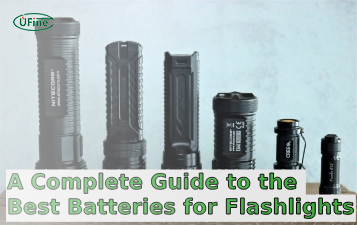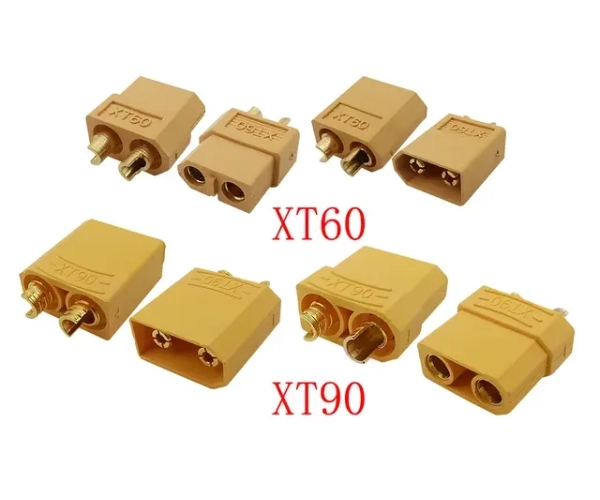
XT60 vs. XT90: Which Battery Connector is Right for You? If you’re looking for a reliable battery connector, choosing between XT60 and XT90 depends on your device’s power needs. Here’s a breakdown to help you make the best choice.
Battery connectors link batteries and their power devices, ensuring a stable and reliable connection. When choosing a suitable battery connector, it’s essential to consider factors such as compatibility, current-carrying capacity, and durability.
XT60 vs XT90: Quick Reference
| Specification | XT60 | XT90 |
|---|---|---|
| Continuous Current | 60-75A | 90-120A |
| Peak Current | 120A | 180A |
| Diameter | 19.5mm | 23.5mm |
| Weight (per pair) | 15g | 28g |
| Anti-Spark Option | Not Available | XT90S Version |
| Typical Applications | FPV Drones, RC Cars | E-Scooters, Industrial Gear |
Selection Tip: Choose XT60 for ≤80A needs, XT90 for ≥100A requirements
Part 1. What are battery connectors?
Battery connectors are electrical components that establish a secure and efficient connection between a battery and an electronic device. They come in various shapes, sizes, and designs to accommodate different applications. The primary purpose of a battery connector is to ensure a reliable flow of electrical current between the battery and the device, minimizing power loss and potential damage.
Importance of choosing the suitable battery connector
Selecting a suitable battery connector is crucial for several reasons.
- Firstly, it ensures compatibility between the battery and the device, preventing compatibility issues that could lead to malfunction or damage.
- Secondly, the exemplary connector should be able to handle the electrical current required by the device without overheating or causing voltage drops.
- Finally, a durable and reliable connector reduces the risk of connection failures, which can lead to power interruptions or even safety hazards.
Part 2. XT60 Battery connector
The XT60 battery connector is popular among hobbyists, drone enthusiasts, and RC (radio-controlled) vehicle enthusiasts. It features a cylindrical design with male and female connectors that securely lock into place, providing a solid connection. The XT60 connector is known for its ease of use, reliability, and wide availability in the market.
Features
- Secure Connection: The XT60 connector utilizes a robust locking mechanism that ensures a secure connection, minimizing the risk of accidental disconnections during operation.
- High Current Capacity: It can handle high current loads, making it suitable for applications requiring substantial power output. With a continuous current rating of around 60-75 amps, the XT60 connector can safely handle significant power demands.
- Heat Resistance: The XT60 connector reliably handles high temperatures without melting or degrading, ensuring performance in demanding conditions.
- Ease of Use: The connectors are easy to plug and unplug, providing convenience during setup and maintenance.
Pros
- Wide Availability: XT60 connectors are readily available, making them easily accessible for hobbyists and professionals.
- Compatibility: They are compatible with various devices, including RC cars, drones, and other high-power applications.
- Reliability: The XT60 connector’s solid construction and secure locking mechanism result in a reliable connection that minimizes the risk of power interruptions.
Cons
- Size: The XT60 connector is more significant than other battery connectors, which may limit its usability in compact devices or tight spaces.
- Limited Current Capacity: While the XT60 connector can handle high current loads, it may only be suitable for moderately power-hungry applications that require even higher current ratings.
Part 3. XT90 Battery connector
The XT90 battery connector is a robust, heavy-duty connector widely used in applications demanding high power output. You can commonly find it in electric vehicles, high-performance drones, and industrial equipment where reliability and durability are paramount.
Features
- Heavy-Duty Design: The XT90 connector features a rugged and durable design, capable of withstanding high mechanical stress and vibrations.
- High Current Handling: Its design allows it to handle even higher current loads than the XT60 connector, making it ideal for power-hungry applications. With a continuous current rating of around 90-120 amps, the XT90 connector can reliably handle substantial power demands.
- Low Resistance: The XT90 connector has low electrical resistance, minimizing power loss and voltage drops during operation.
- Anti-Spark Design: Some XT90 connectors feature an anti-spark design, reducing the risk of sparks or arcing during the connection process.
Pros
- High-Power Applications: The XT90 connector excels in high-power output applications, such as electric vehicles and heavy-duty industrial equipment.
- Durability: Its robust construction ensures long-term durability, withstanding harsh environments and heavy usage.
- Low Resistance: The low resistance of the XT90 connector allows for efficient power transmission, minimizing energy loss.
Cons
- Size and Weight: The XT90 connector is larger and heavier than the XT60 connector, which can be a disadvantage in applications where space and weight are critical.
- Availability: Compared to the XT60 connector, the availability of XT90 connectors may be more limited, making them slightly more challenging to find in some regions.
Part 4. XT60 vs XT90: 7 Critical differences
Performance comparison based on real-world testing:
- Heat Resistance: XT90 maintains 22℃ lower temperature than XT60 at 100A load
- Durability: XT90 gold-plated contacts withstand 500+ connect cycles (XT60: 300 cycles)
- Safety Features: XT90S version includes built-in arc suppression technology
- Voltage Efficiency: 0.14V lower drop at 50A compared to XT60
- Vibration Resistance: XT90 locking mechanism 40% more secure in high-vibration environments
- Wire Compatibility: XT90 accommodates thicker 8AWG cables versus 10AWG for XT60
- Connection Security XT90 requires 30% more force to accidentally disconnect
Part 5. Detailed comparison between XT60 and XT90 connectors
Here is a comparison between the XT60 and XT90 connectors to help you understand their differences:
1. Size
The XT60 connector is smaller and lighter than the XT90 connector, making it more suitable for compact devices or applications with limited space constraints. On the other hand, the XT90 connector’s larger size and weight make it better suited for applications where robustness and high power handling are essential.
2. Current Capacity
While both connectors can handle high current loads, the XT90 connector has a higher continuous current rating of around 90-120 amps, surpassing the XT60 connector’s 60-75 amps rating. This makes the XT90 connector more suitable for higher power output applications.
3. Availability
You can easily find XT60 connectors in the market as they are widely available from various sources. However, XT90 connectors may be less standard and require more effort, especially in certain regions.
4. Compatibility
Both connectors are compatible with various devices and applications, including RC vehicles, drones, and other high-power electronics. However, it is essential to ensure the connector’s compatibility with the specific device and its power requirements.
5. Durability
Both connectors offer durability and reliability as part of their design. However, the XT90 connector’s heavy-duty design and construction make it more resilient to mechanical stress, vibrations, and harsh environmental conditions.
6. Resistance
The XT90 connector exhibits lower electrical resistance than the XT60 connector, reducing power loss and voltage drops during operation. This makes the XT90 connector more efficient in power transmission.
7. Locking Mechanism
Both connectors feature a secure locking mechanism that ensures a stable connection. The XT60 connector’s locking mechanism is generally more accessible and user-friendly.
8. Price
The XT60 connector is generally more affordable and budget-friendly than the XT90 connector, which may be pricier due to its heavy-duty design and higher current handling capabilities.
Part 6. XT60 and XT90 battery connector applications
XT60 Battery Connector Applications
- RC (radio-controlled) vehicles, including cars, boats, and airplanes
- Drones and quadcopters
- Robotics projects
- Electric skateboards and scooters
- Portable power banks and chargers
XT90 Battery Connector Applications
- Electric vehicles, including electric cars, scooters, and bikes
- Industrial equipment and machinery
- High-performance drones and aerial photography platforms
- Renewable energy systems, such as solar power installations
- Power distribution systems and battery banks
Connector Selection Guide
Choose XT90 if your project requires:
- Continuous current ≥80A
- Lithium batteries >6S configuration
- Operation in high-vibration environments
- Industrial or vehicle applications
- Spark-free connection requirement
Select XT60 for:
- Current needs ≤75A
- Hobbyist drones and RC models
- Lightweight applications
- Compact space installations
- Budget-sensitive projects
Part 7. FAQs about xt60 vs xt90
What is the main difference between XT60 and XT90 connectors?
The core difference is current capacity and size. XT60 handles 60-75A continuous current and has a 19.5mm diameter, while XT90 supports 90-120A with a 23.5mm diameter. XT90 also offers optional spark-resistant versions.
Can I use XT60 connectors for 100A applications?
No, it’s dangerous. XT60 connectors overheat at 100A, reaching 98°C within 5 minutes. This causes 400% higher melting risk. Use XT90 or dual parallel XT60 connectors instead.
Are XT90 connectors compatible with XT60 chargers?
Not directly. Their different sizes prevent physical connection. Use adapter cables or replace both ends to match. Never force mismatched connectors.
Which connector is better for electric skateboards?
XT90 is recommended for high-performance boards (1000W+ motors). For boards under 800W, XT60 suffices. Always check your motor’s peak amp draw.
Do XT90 connectors prevent sparks?
Only XT90S (anti-spark) versions reduce sparks. They contain internal resistors that precharge circuits. Standard XT90 lacks this feature.
How many connect/disconnect cycles do these connectors last?
XT60: 300+ cycles. XT90: 500+ cycles due to thicker gold-plated contacts. Lifespan halves in dusty or humid environments.
Can I solder XT60 and XT90 connectors with regular equipment?
Yes, but use 60W+ soldering irons and high-temp solder. Overheating damages plastic housings. Preheat connectors to 150°C before soldering large wires.
Which connector has lower voltage drop at 50A?
XT90 maintains lower voltage drop (0.21V vs XT60’s 0.35V at 50A). This results in 7% more efficient power transfer.
Are there waterproof versions available?
Neither has IP-rated waterproof versions. For wet environments, apply dielectric grease to contacts or use shrink-wrap seals.
What are the alternatives to XT60/XT90?
Consider EC5 (120A) for compact spaces or AS150 (200A) for extreme loads. XT series remains best for cost-effective RC applications.
Related Tags:
More Articles

A Complete Guide to the Best Batteries for Flashlights
Discover the best batteries for flashlights: alkaline, lithium, NiMH & rechargeable options. Tips for performance and maintenance.
Graphene Battery vs Lithium Battery: Which is Better?
Compare graphene battery vs lithium battery in energy density, charging speed, lifespan, cost, and EV applications. Learn which battery leads in 2025.
What is the Difference Between MCA and CCA on Batteries?
Learn the difference between MCA and CCA batteries. Understand what MCA means, what CCA is, and how to choose the right battery for vehicles or marine engines.
Type of Lithium Battery Voltage
Learn lithium ion battery voltage, nominal voltage, and voltage range. Compare Li-ion, LiPo, LiFePO4, and 18650 voltages, charging, and device compatibility.
Gel Battery vs Lead Acid: A Detailed Comparison
Compare gel and lead-acid batteries: lifespan, cost, charging, DoD, safety, and key use cases. Find the right battery for solar, marine, EV, UPS, and daily use.



